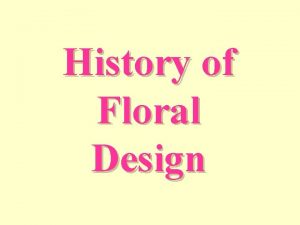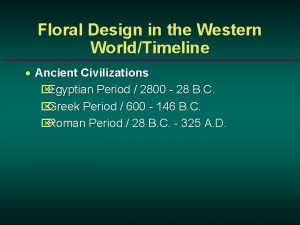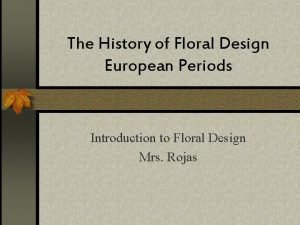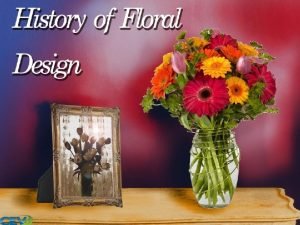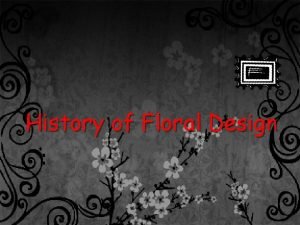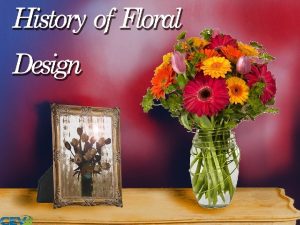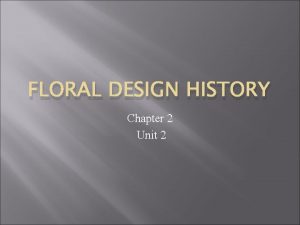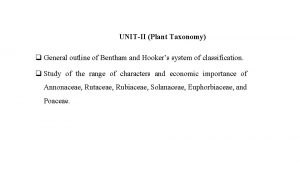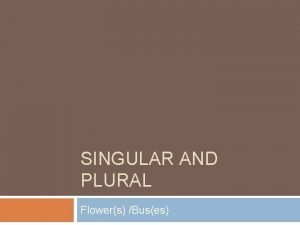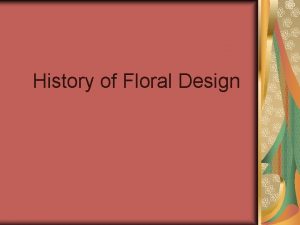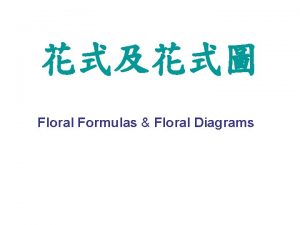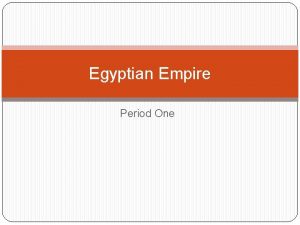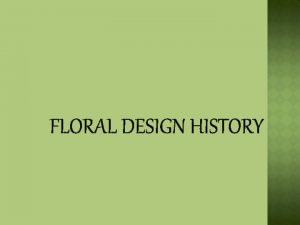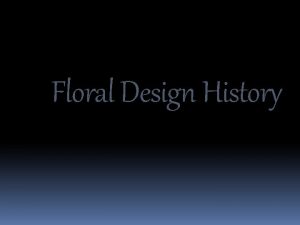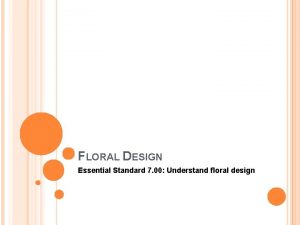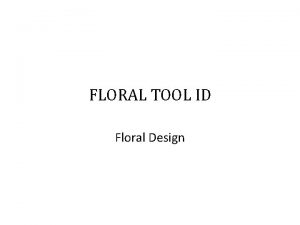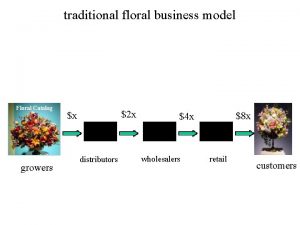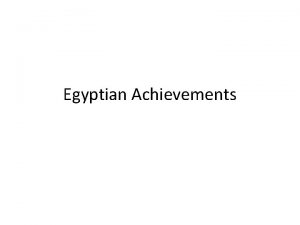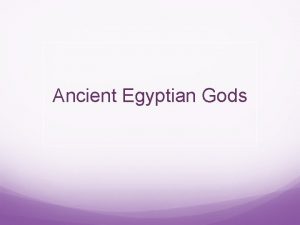The History of Floral Design Egyptian Floral Design











































- Slides: 43

The History of Floral Design

Egyptian Floral Design • Began in 2800 B. C. to 28 B. C. • We discovered floral design through artifacts and wall paintings • Used for decoration in – Temples – Banquet Tables – Wreaths for guests – Used in processions – Given to honor someone

Egyptian Floral Design • Orderly, alternating patters • Simplistic, repetitious, and highly stylized • Placed in spouted vases with no stem visible • Set in regimented rows • Around the edge of the vase (2 inches above the rim) • Blossoms were flanked by leaves or buds on lower stems. • No bunching or overlapping of material.

Flowers used in Egyptian Design -Acacia -Madonna lilies -Narcissus -Roses -Jasmine -Water lilies -Poppies -Violets -Lotus blossom ( were considered sacred)

Greek Floral Design • This Period Began 600 B. C. – 46 B. C. • The ancient Greeks were so dedicated to beauty that their art heritage has lived through the ages and influences today’s art. Herbs were frequently used with the flowers, and as garlands, and wreaths. They introduced the Horn of Plenty or Cornucopia. • •

Greek Floral Designs • Greek designs expressed grace and simplicity • Color was not important • the flowers, fragrance, and symbolism associated with each flower were foremost importance • Often symbolic of a god or hero

Flowers Used in Greek Designs Roses Hyacinths Honeysuckle Violets Lilies Tulips Larkspur Marigolds

Roman Floral Design • 28 -B. C. -325 A. D. • The Romans continued with the customs of the Greeks. • Garlands, wreaths and crowns were more elaborate than those of the Greeks. Crowns and garlands were tapered. • Flowers were sometimes arranged in baskets and cornucopias. . Use as made of the fragrance of flowers.

Roman Floral Design • “Dies Rosationis” - After a person dies the family would gather at a rose bedecked grave and lay more roses in remembrance of that person. • “Sub Rosa” - Roman custom of hanging a wreath of white roses from the ceiling, and all things said beneath the wreath was to be kept a secret.

Flowers Used in Roman Design Poppy Roses Amaranths Crocus Ivy Narcissi Oleanders Myrtle Violets Honeysuckle Laurel Lily

Byzantine Floral Design • 320 -600 AD • Continued Roman designs • Elaborate containers had nearly pointed bases. • Used symmetrical tree -like compositions

Byzantine Floral Design • Changed construction of garlands to be narrow bands of flowers or fruit alternated with foliage • Formal conical designs with clusters of blossoms at regular intervals

Middle Ages Floral Design • (476 -1400 AD) • Flowers arranged in vases • Symmetrical groups in Chinese flasks show Chinese influence. • Little known about floral designs of this period • Information found in Persian art, rugs, and tapestries.

Renaissance Floral Design • Renaissance period saw a rebirth of many interests, particularly in the arts. • The Renaissance began in Italy but quickly spread to all of Europe. • The Renaissance style was greatly influenced by the Byzantine, Greek, and Roman

Renaissance Floral Design • Stems were covered creating a massed, symmetrically stiff arrangement. • In this era, the Christmas Wreath became popular • Fruits, blossoms and leaves were woven into garlands to decorate walls and vaulted ceilings • Petals were piled into baskets to strew on floors and streets or to float down from

Flowers used in Renaissance Design Roses Ivy Olive Branches Lily of the Valley Laurel Dianthus Lilies Violets Daisies Primroses

Baroque and Flemish Style Period • (1600 -1775 AD) • Classical Renaissance style gave way to the lavish Baroque style • Symmetrical oval shaped designs • Hogarthian curve or SCurve developed this period

Baroque and Flemish Style Period • Styles were evoked by the works of Michelangelo in Italy, but these were adopted by designers in Holland Belgium. • Large containers held flamboyant arrangements containing many different kinds of flowers.

Flowers Used in the Baroque and Flemish Style Era Iris Marigold Lily Peony Cannas Hollyhock Roses

English Georgian Period • (1714 -1760) • The 15 th and 16 th Century collective fortresses of England gave way to smaller houses, into which flowers were brought, more for their fragrance than their beauty. • Arrangements during the first half of this period consisted of flowers simply crammed into sturdy containers, with little or no concern for design. • Some of the containers of the period were made specifically to hold flowers, with holes or openings to maintain the stems at particular angles.

Floral Design in French Period All of these design periods fall under one Category : • French Baroque • French Rococo (18 th Century) • Louis XVI (Late 18 th Century) • Empire Period (1804 -1814)

French Baroque • The topiary was introduced during this period. Symmetrical designs with no focal point. • Floral designs were informal, fragile, and delicate.

French Rococo (18 th Century) • Designs more formal than those of the Baroque period, predominantly arc and crescentshaped, delicate and airy.

Louis XVI (Late 18 th Century) • Delicate, cool colors before the French revolution, and the revival of the Classical Period following the French revolution.

Empire Period (1804 -1814) • Military symbolism was often used in arrangements, using emblems and figures associated with the emperor. Most of the designs were simple and triangular in shape.

Victorian Era 1820 -1901 • The Victorian era named for Queen Victoria, marked a period of floral design, in which we often see elaborate and full designs. • Upper-class members of society showed their wealth with large, excessive, opulent and often overdone flower arrangements.

Victorian Era • This era was the first attempt to establish rules for floral arranging • Arrangements were created weekly by cultured ladies and their daughters in the home. • This was also the time when tussiemussie bouquets and nosegay bouquets made their mark in society. Proper women of Victorian society carried these bouquets at most social gatherings.

Victorian Era • Victorian style arrangements are typically round or oval in form. Flowers are typically kept to a lower height, • Strong color contrasts and flowers with brilliant hues were preferred • Lots of foliage is associated with Victorian style arrangements. • Fruit may be added to the arrangement also, mainly because the flowers are cut from the garden that are being used.

Victorian Era Language of Flowers • Victorians knew the language of flowers and carefully selected their arrangements or single flowers according to the message. • they wanted to convey to the recipient. • A gift of a bouquet of chrysanthemums meant love; a red carnation meant that feelings weren’t mutual and lavender meant luck or devotion

Flowers Used in the Victorian Era Roses Tulips Carnations Lilies Daisies Peonies Fruit

Early American (Colonial) Period • (1620 -1720) • The early colonists generally produced plants for food or for their medicinal properties. • What little time they had for arranging flowers was spent making simple arrangements to adorn their very modest homes. • Flowers were used more in the Central and Southern Colonial areas. • Most of the arrangements they made were copied from the English Georgian and French Empire periods. • Arrangements were made in simple mass forms using numerous colors.

Colonial Williamsburg Floral Design • (1740 -1780) • Colonial Williamsburg is renowned for it’s colorful arrangements in finger vase and flower bricks. • The English and European roots particularly in the Georgian and French designs became more symmetrical and sophisticated. • Fan and Triangular-shaped flower arrangements where lightly grouped at the top, sometimes 11/2 to three times the height of their containers.

Flowers Used in Colonial Williamsburg Design Lilies Anemones Roses Cockscomb Sunflowers Strawflower Violets Marigolds Daisies Ornamental grasses Snapdragons

American Period Floral Design • (1780 -1820) • The Neoclassic and Empire styles which had been evolving in Europe, especially the delicate French style, had a great influence on the styles used in late colonial America at this time. • In these types of arrangements, masses of mixed bouquets were used less often, and the charm of individual flowers was emphasized. Fewer flowers

American Victorian Period • (1800 -1920) • The Victorian period in England began to spill over to the newly-declared United States. • Ornate containers of many different kinds of materials were filled to overflowing, using cool colors and an abundance of white. • Arrangements tended to be made in rich purples, magentas, and dark blues. and the Tuzzy-Muzzy was popular, especially in the deep ´South´.

Modern Period (Contemporary) Floral Design • Art nouveau 1890 -1910 • Art Deco 1920’s – 1930’s • Free Form Expression 1950’s • Geometric Mass Design 1960’s – 1970’s • Modern American

Modern Period (Contemporary) Floral Design Art Nouveau • Based on curvilinear lines and often patterned after nature in the shape of plants/flowers • Containers were carving and asymmetrical

Modern Period (Contemporary) Floral Design Art Deco • Influenced by ancient Egyptian, Jazz age, and the industrial age. • Characterized by strong geometric lines and patterns • The style reemerged in the 1960’s • Corsages became popular in this time period.

Modern Period (Contemporary) Floral Design Free Form Expression • Arrangements became more expressive with feeling or movement and freedom • Textural differences between design materials were emphasized

Modern Period (Contemporary) Floral Design Geometric Mass Design • Tight, geometric bouquets were common • Arrangements combined mass and line into stiff patterns • Compote containers were commonly used.

Chinese and Japanese Floral History

Chinese Influences • • • The Chinese were making flower arrangements as far back as 207 BCE to 220 CE, in the Han era of ancient China. Flowers were an integral component of religious teaching and medicine. Practitioners of Buddhism, Taoism, and Confucianism placed cut flowers on their altars. This practice dates back to 618 -906 CE. Buddhist teachings forbade the taking of a life, so religious practitioners worked sparingly when taking cuttings from plants. Flowers and leaves that were used to make basket arrangements were selected based on their symbolic meaning.

Japanese Influence • • The truth about the origin of Ikebana is unidentified. But when the Buddhism reached Japan in the 7 th century, it is thought to have come to Japan as part of Buddhist practice. The offering of flowers on the altar in honor of Buddha was part of worship. Ikebana evolved from the Buddhist ritual of offering flowers to the spirits of the dead[1]. The first classical styles of Ikebana started in the middle of the fifteenth century; the first students and teachers of Ikebana were Buddhist priests and members. As time passed, other schools emerged, styles changed, and Ikebana became a custom among the Japanese society. Another aspect present in ikebana is its employment of minimalism. That is, an arrangement may consist of only a minimal number of blooms interspersed among stalks and leaves. The structure of a Japanese flower arrangement is based on a scalene triangle delineated by three main points, usually twigs, considered in some schools to symbolize heaven, earth, and man and in others sun, moon, and earth. The container is a key element of the composition, and various styles of pottery may be used in their construction.
 Greek floral arrangements
Greek floral arrangements Victorian period victorian era floral design
Victorian period victorian era floral design Classical revival floral design
Classical revival floral design Floral history timeline
Floral history timeline Floral design floral pricing worksheet
Floral design floral pricing worksheet Egyptian history is divided into
Egyptian history is divided into European floral design history
European floral design history Objectives of flower arrangement
Objectives of flower arrangement Occidental style
Occidental style American federal floral design history
American federal floral design history Early american floral design
Early american floral design Ancient egyptian interior design
Ancient egyptian interior design Floral formula annona squamosa floral diagram
Floral formula annona squamosa floral diagram Singular of bus
Singular of bus Hình ảnh bộ gõ cơ thể búng tay
Hình ảnh bộ gõ cơ thể búng tay Lp html
Lp html Bổ thể
Bổ thể Tỉ lệ cơ thể trẻ em
Tỉ lệ cơ thể trẻ em Gấu đi như thế nào
Gấu đi như thế nào Thang điểm glasgow
Thang điểm glasgow Alleluia hat len nguoi oi
Alleluia hat len nguoi oi Môn thể thao bắt đầu bằng chữ f
Môn thể thao bắt đầu bằng chữ f Thế nào là hệ số cao nhất
Thế nào là hệ số cao nhất Các châu lục và đại dương trên thế giới
Các châu lục và đại dương trên thế giới Cong thức tính động năng
Cong thức tính động năng Trời xanh đây là của chúng ta thể thơ
Trời xanh đây là của chúng ta thể thơ Mật thư tọa độ 5x5
Mật thư tọa độ 5x5 Phép trừ bù
Phép trừ bù độ dài liên kết
độ dài liên kết Các châu lục và đại dương trên thế giới
Các châu lục và đại dương trên thế giới Thơ thất ngôn tứ tuyệt đường luật
Thơ thất ngôn tứ tuyệt đường luật Quá trình desamine hóa có thể tạo ra
Quá trình desamine hóa có thể tạo ra Một số thể thơ truyền thống
Một số thể thơ truyền thống Cái miệng nó xinh thế chỉ nói điều hay thôi
Cái miệng nó xinh thế chỉ nói điều hay thôi Vẽ hình chiếu vuông góc của vật thể sau
Vẽ hình chiếu vuông góc của vật thể sau Thế nào là sự mỏi cơ
Thế nào là sự mỏi cơ đặc điểm cơ thể của người tối cổ
đặc điểm cơ thể của người tối cổ Thế nào là giọng cùng tên? *
Thế nào là giọng cùng tên? * Vẽ hình chiếu đứng bằng cạnh của vật thể
Vẽ hình chiếu đứng bằng cạnh của vật thể Fecboak
Fecboak Thẻ vin
Thẻ vin đại từ thay thế
đại từ thay thế điện thế nghỉ
điện thế nghỉ Tư thế ngồi viết
Tư thế ngồi viết


